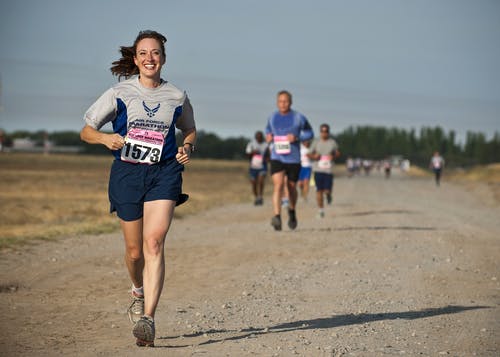Whilst weight loss is undoubtedly one of the most common health and fitness goals, it is sometimes wrongly viewed as the key determinant of progress when trying to improve our exercise and nutrition habits. One of the most common questions personal trainers gets asked by people who have recently embarked on a new plan is ‘why haven’t I lost much weight?’ There are many possible reasons for this, including the fact that we all lose weight at different rates, you may be building muscle and you could be getting weighed at different times of the day or week and/or using different scales. These are just a few explanations, but the majority (if not all) of the personal trainers I know would urge their clients to explore other ways of measuring progress rather than the often soul-destroying focus of chasing a certain number on the scales. Embarking on a new healthy living plan should leave you feeling energised, proud and encouraged. If the scale is having the opposite effect, consider giving it a break for a while and focusing on other ways of measuring progress such as those below…
Improved energy levels – As contradictory as it sounds, exercise can help to boost energy levels. Whilst it may be the last thing we feel like doing when we’re tired, exercising can increase our mental sharpness thus making us feel more awake and alert. It also increases our heart rate and blood flow and so can energise our body as opposed to being sat still. As we build muscle over time, our energy levels can feel higher as our everyday activities take up less of our maximal strength (see below). You may also find that your stamina increases and you tire more slowly when doing your workouts or everyday activities such as housework, walking or playing with your children or grandchildren.
Increased strength – At the start of a new training plan, you should consider doing some baseline ‘tests’ including noting down the weights and number of sets and reps you can manage on certain exercises. These could include exercises such as squats, bicep curls, sit ups and shoulder press but you should choose these exercises based on your personal goals and training plan. Seek the support of a fitness professional for this if necessary and retest these exercises at regular intervals as you progress through your plan. Another way you may notice increased strength is in your everyday activities such as carrying your shopping, climbing stairs or even going from seated to standing. These activities will take less of our overall strength and thus feel less taxing.
Improved mood – Exercise causes the body to release endorphins which are natural mood-boosters. They also help to reduce pain. Exercise can also have a positive effect on levels of stress and anxiety related hormones such as cortisol and adrenaline and so can have a calming and relaxing effect both immediately and longer term. Exercising can give us feelings of pride and self-confidence. Try keeping a mood journal or diary as you make lifestyle changes, for example rating your overall mood, confidence, and life satisfaction levels daily or weekly and comparing this to how you felt before making healthy changes.

Better sleep – A commonly researched benefit of exercise includes improvements in sleep quality and duration. Exercising during the day can help to tire us out and use up excess energy thus making us more able to sleep at night. Our body needs sleep and rest to recover from our workouts and so will naturally want this to get the best from our efforts. The benefits of exercise on our mental health can also improve our sleeping habits as our minds may feel less stressed and more relaxed following a workout and so less likely to keep us awake with worries when our head hits the pillow. Exercise can also help to release muscular tension which can have a sedative effect, with pursuits such as yoga and stretching being particularly good for this. If exercising close to bedtime, many people find they need to stick to these slower types of exercise but it’s all about finding what works for you and seeking professional guidance if necessary.
Your appetite is more well-regulated – As exercise can help to increase our energy levels (as described above), it can reduce our tendency to reach for high calorie, sugary and often processed foods in a bid to boost our energy. When we are determined to workout and have planned it into our schedule, we are often much more conscious of fuelling our bodies correctly and more inclined to portion control afterwards. As exercise can increase our appetite, it can help us to learn our bodies genuine hunger cues as opposed to wanting to eat out of habit, boredom or other emotions as many of us often do!
You get ill or injured less – Once you start feeding your body a healthier and more balanced diet, you are likely to be getting plenty of vitamins and minerals which are essential for our immune defences. A lack of certain nutrients can leave us more susceptible to illnesses such as colds, flu and injuries. Exercise has also been found to have benefits to the immune system (as long as it’s not in excess) and so healthy lifestyle changes may well leave us in a much better position to fend off illness and injuries and we may find ourselves experiencing them much less frequently or less intensely.

Your clothes fit better – We’ve all been there where the scales haven’t moved but our clothes fit differently (whether for better or worse!) Many people report that whilst their weight hasn’t reduced, their clothes fit much better and their body shape has changed after changing their diet and exercise habits. This is because our body composition can change (water, fat, muscle etc), whilst our total weight remains relatively stable.
To monitor this, measure yourself in key areas including waist, hips, thighs and upper arms before embarking on lifestyle changes and check these at regular intervals over time. On this note, despite the common (misinformed) quote, muscle does not weigh more than fat! One pound of fat and one pound of muscle weight the same (it’s given away in the words!), but one pound of muscle will take up less SPACE than the same amount of fat. It is more dense and so a bodybuilder and a person with a lot of excess body fat can weight the same but will look very, very different! This is one of the most simplistic ways to understand body weight vs body composition.
You look ‘better’ – Be careful with this one as I tend to steer away from purely appearance related goals and we often tend to be so harsh on ourselves that even if we have made positive changes, we still don’t stop to applaud ourselves! That said, a common way of tracking changes in your body is by taking ‘progress photos’, sometimes known as ‘before and after photos’. When starting a new plan, take photos of yourself at different angles include front facing, back facing and side facing and repeat these shots at periodic intervals. It can be much easier to see progress when photos are viewed side by side as opposed to trying to remember how our body looked however many weeks or months ago!

You’re enjoying exercise more – Last, but certainly not least, a great way of measuring progress is how much you’re enjoying your workouts and your levels of motivation. Of course, we all have fluctuations with this but if you manage to shift your focus from your weight and a number on the scales you are likely to reduce any disappointment you felt when the result wasn’t exactly what you were hoping for or felt you deserved for all your hard work. This can help to boost motivation as we are simply looking forward to exercise for how it makes us feel and the various other ways it improves our life and wellbeing rather than thinking it’s ‘pointless’ if we don’t see those scales shift which is a mindset so many are stuck in. If you can find an exercise you enjoy, look forward to (most of the time at least) and appreciate for how it makes you feel, you are far more likely to maintain this as a long-term lifestyle change rather than a temporary plan that’s sole purpose is to reveal a certain number on a scale. If you are solely chasing that number, your weight will inevitably yo-yo again when you stop whatever ‘gruelling’ regime got you there. The irony is, by shifting your perspective to all these other benefits, you are far more likely to maintain a healthy weight in the long term.
*Sidenote – all of these ways of tracking progress are meant as suggestions only. If you feel any of these may be ‘triggering’ or juts not right for you such as taking photographs or focusing on your mood, please don’t feel you need to try them. We’re all different and what works for one person might not work best for another ?
If you do still want to weigh yourself using scales and throwing them out feels scary or unnecessary, try limiting it to once a week maximum. Weigh yourself using the same scales in the same place and at the same time. Ideally this would be first thing in the morning before any food or drink is consumed and wearing as little as possible to get a true body weight. If you attend a gym or other sports facility, many now have more ‘advanced’ scales such as Tanita or Boditrax scanners that track many variables such as water levels, fat mass, muscle mass and overall weight. These can give a clearer picture of your body as opposed to a solitary number, but it’s important to still exercise caution with these scales and try and stick to the guidelines above.
If you have any questions, comments or feedback as always please feel free to contact Mike at Hamers360 fitness or Bev (see below).
Written by Bev Meakin – Personal Trainer/ Exercise Referral Officer and Complementary Therapist. Instagram @bevs_life

